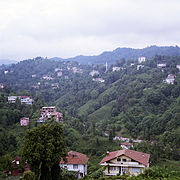| Rize Tea | |
|---|---|
 | |
| Type | Black |
| Other names | Rize çayı, Çay |
| Origin | Rize Province, Turkey |
| Quick description | Turkish tea produced in the eastern Black Sea province of Rize |
Rize tea (Turkish: Rize çayı) is the black tea used for Turkish tea. Produced in Rize Province of Turkey which has a mild climate with high precipitation and fertile soil, when brewed it is mahogany in color.[1]
In addition to being consumed at home, it is served in Turkish cafés by a çaycı, in small, narrow-waisted glasses. It can be taken strong (Turkish: demli or dark) or weak (Turkish: açık or light), and is traditionally served with beet sugar crystals (Turkish: toz şeker) or a couple of sugar lumps (Turkish: kesme şeker),[2][3] although it's frequently consumed without any sugar, depending on personal preference.
History[edit]
Rize Province is located between the Pontic Mountains and the Black Sea, and is considered to be the "wettest" corner of Turkey; this environment provides a specific ecosystem for tea growing.[4] The land contains many mountain valleys and has been prized for its biodiversity.[5][6]
Tea was experimentally farmed in the Rize Province, starting in 1912 as an initiative by the Head of the Chamber of Agriculture, Hulusi Bey.[7] But it was not until around 1945, that Turkish tea plantations in Rize Province were producing sizable crops.[8] There are other regions of tea growing within Turkey, with Rize Province being one of the largest and more successful.[8][9] By 1947, the first local tea factory was created and by 1958, the first regional tea research institute was created in Rize Province.[10][4]
Labor[edit]
The success of tea crops in Rize brought work and wealth to a once impoverished area, as well as a large population change.[4] Modern day harvesting of Rize tea crops has been done by migrant laborers, especially people from the Caucasian countries of Georgia and Azerbaijan.[10][5] In 2021, the tea plantations were expecting 40,000 foreign workers during the harvest season however due to the COVID-19 pandemic travel restrictions, African laborers came to the region to work instead (specifically from Gambia, Senegal, Sudan and Zambia).[10]
-
Tea plantation in Rize
-
Tea plantation in Rize
References[edit]
- ^ Saberi, Helen (2010-10-15). Tea: A Global History. Reaktion Books. pp. 78–79. ISBN 978-1-86189-892-0.
- ^ Janger, Kathie. Just Your Cup of Tea. Standard International Media. p. 19. ISBN 978-1-60081-649-9.
- ^ Yousuf, Ambreen (2021-04-20). "Tea culture in Turkey, Kashmir: Types, brewing, health benefits". Daily Sabah. Retrieved 2021-10-08.
- ^ a b c "Rize". Bologna Course Package, Recep Tayyip Erdoğan Üniversitesi. Retrieved 2021-10-08.
- ^ a b "Familial cases haunt Turkey's coronavirus hot spot Rize". Daily Sabah. 2021-09-12. Retrieved 2021-10-08.
- ^ Gall, Carlotta (2021-05-29). "After Erdogan Angers a Loyal Province, His Opponents See an Opportunity". The New York Times. ISSN 0362-4331. Retrieved 2021-10-08.
- ^ McWilliams, Mark (2018-07-01). Food and Landscape: Proceedings of the 2017 Oxford Symposium on Food and Cookery. Oxford Symposium. p. 374. ISBN 978-1-909248-62-5.
- ^ a b Klasra, M. A.; Khawar, K. M.; Aasim, M. (2007). "History of tea production and marketing in Turkey". International Journal of Agriculture and Biology (Pakistan). ISSN 1560-8530.
- ^ Ergener, Rashid (2002). About Turkey: Geography, Economy, Politics, Religion, and Culture. Pilgrims Process, Inc. p. 41. ISBN 978-0-9710609-6-8.
- ^ a b c "African workers lend a hand in Rize's tea gardens - Turkey News". Hürriyet Daily News. May 27, 2021. Retrieved 2021-10-08.

